Welcome to your ultimate guide to horticulture, where I will reveal the secrets to developing a green thumb and creating a thriving garden. Whether you’re a beginner or an experienced gardener, this comprehensive guide will provide you with all the information you need to succeed in horticulture. From understanding the importance of soil preparation to discovering the best techniques for plant growth, you’ll learn the key strategies that will set you on the path to becoming a successful gardener.
In horticulture, it is important to consider the depth and extent of plants’ root systems. The roots of garden plants, such as tomatoes, corn, and pepper plants, can grow over four feet deep. Understanding the size and volume of root systems is crucial for proper soil preparation and plant growth. When planting shrubs or flowers, it is essential to have loam, a type of soil rich in organic material. Fill soil, which often contains waste materials, should be removed and replaced with proper loam. Additionally, adding fertilizers like well-rotted cow manure or dehydrated manure can provide the necessary nutrients for plant growth. Seaweed is also a beneficial source of minerals for plants. By following these green thumb secrets, gardeners can ensure healthy and thriving plants in their horticultural endeavors.
Key Takeaways
- Understanding the depth and extent of plants’ root systems is crucial for proper soil preparation and plant growth.
- Loam, a type of soil rich in organic material, is essential for planting shrubs and flowers.
- Removing fill soil and replacing it with proper loam is necessary for optimal plant growth.
- Fertilizers like well-rotted cow manure, dehydrated manure, and seaweed provide essential nutrients for plants.
- Following these green thumb secrets will ensure healthy and thriving plants in your garden.
Now that you understand the importance of root systems and soil preparation, let’s dive deeper into the joy of gardening in the next section.
The Joy of Gardening
Discover the joy of gardening and learn how it can enhance your life in this section of the guide. Gardening is not just about growing plants; it’s a transformative experience that allows you to connect with nature, reduce stress, and cultivate a sense of accomplishment. Whether you have a small balcony or a spacious backyard, horticulture is accessible to everyone, regardless of their level of expertise.
When you immerse yourself in the world of gardening, you become part of a community of like-minded individuals who share a passion for plants. It’s a chance to learn from experienced gardeners, exchange tips and tricks, and discover new varieties of flowers, fruits, and vegetables. The act of tending to plants, nurturing them from seeds to blooming beauties, is a rewarding process that brings a sense of fulfillment and satisfaction.
Not only does gardening offer mental and emotional benefits, but it also promotes physical wellbeing. Spending time outdoors, breathing in fresh air, and getting your hands dirty can boost your immune system and improve overall health. The gentle exercise involved in tasks such as digging, weeding, and watering can help strengthen muscles and increase flexibility.
So why not embark on your own horticultural journey and experience the joys of gardening? Start small with a few potted plants or create a thriving garden oasis. No matter the scale, the act of nurturing life will bring you closer to nature and provide a sense of purpose. Join me in exploring the wonders of horticulture and unlock the secrets of a greener thumb!

Growing Your Own Produce
Unlock the secrets to growing your own fresh and delicious produce with the tips and techniques shared in this section. In horticulture, it is important to consider the depth and extent of plants’ root systems. For instance, garden plants like tomatoes, corn, and pepper plants have root systems that can grow over four feet deep. Understanding the size and volume of root systems is crucial for proper soil preparation and optimal plant growth.
When it comes to planting shrubs or flowers, having the right soil is essential. Loam, a type of soil rich in organic material, provides an ideal environment for plant roots to thrive. It is important to remove fill soil, which often contains waste materials, and replace it with proper loam to ensure healthy plant growth.
To provide the necessary nutrients for your plants, incorporating fertilizers is key. Well-rotted cow manure and dehydrated manure are excellent natural fertilizers that can improve soil fertility. Another valuable source of minerals for plants is seaweed. By harnessing the power of these organic fertilizers, you can nurture your plants and promote robust growth.
| Organic Fertilizers | Benefits |
|---|---|
| Well-Rotted Cow Manure | Rich in nutrients, improves soil structure |
| Dehydrated Manure | Concentrated nutrients, slow-release |
| Seaweed | Minerals and trace elements, enhances plant health |
By following these green thumb secrets, you can create an environment that supports the growth of healthy and abundant produce. Whether you have a small garden or a spacious backyard, horticulture offers a rewarding opportunity to grow your own food and enjoy the flavors of nature’s bounty.
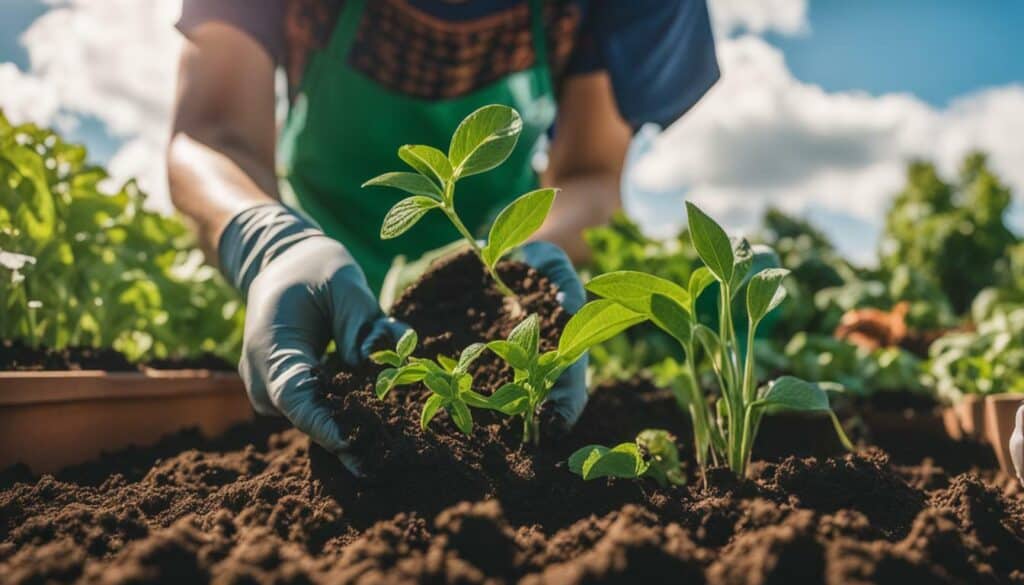
Understanding Root Systems
Dive deep into the world of root systems and learn why they are vital for the success of your garden. In horticulture, understanding the size and volume of root systems is crucial for proper soil preparation and plant growth. Garden plants, such as tomatoes, corn, and pepper plants, have root systems that can grow over four feet deep. Knowing the depth and extent of these root systems is essential for providing the right conditions for your plants to thrive.
When planting shrubs or flowers, it is important to have loam, a type of soil rich in organic material. Fill soil, which often contains waste materials, should be removed and replaced with proper loam to create the ideal environment for root development. By providing plants with the right soil composition, you can ensure that their roots have the necessary nutrients and moisture for optimal growth.
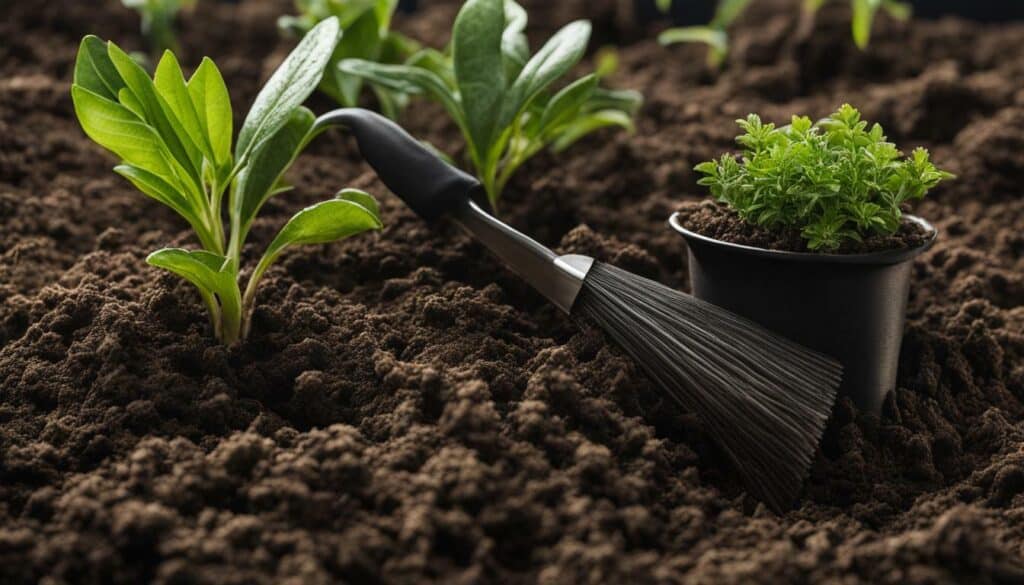
The Importance of Soil Composition for Root Development
Soil composition plays a vital role in root development. Loam, which consists of a balanced mixture of sand, silt, and clay, provides the ideal conditions for roots to penetrate the soil easily and absorb nutrients. The organic matter in loam improves soil structure, allowing for better water retention and drainage.
On the other hand, fill soil often contains debris and waste materials that hinder root growth. By removing fill soil and replacing it with loam, you create a more favorable environment for root systems to thrive. This ensures that your plants have a solid foundation for healthy growth and development.
In addition to soil composition, providing the right nutrients through fertilizers is essential for root development. Well-rotted cow manure and seaweed are excellent sources of organic matter and essential minerals that promote robust root growth. These natural fertilizers enrich the soil, providing the necessary nutrients for healthy roots and vibrant plants.
By understanding the importance of root systems and implementing horticulture best practices, you can create an environment that supports strong and healthy plants. With the right soil composition and proper nutrient management, your garden will flourish, and you’ll be rewarded with a bountiful and thriving horticultural masterpiece.
The Role of Soil in Horticulture
Discover the crucial role of soil in horticulture and how to create the perfect environment for your plants. In the world of gardening, soil is the foundation upon which successful plant growth depends. Different plants thrive in different types of soil, and understanding the characteristics of soil can significantly impact horticultural success. Soil provides essential nutrients, water, and support to plants, making it imperative to create the optimal soil conditions for your garden.
When it comes to soil preparation, one important factor to consider is the depth and extent of a plant’s root system. Did you know that roots of garden plants, such as tomatoes, corn, and pepper plants, can grow over four feet deep? Understanding the size and volume of root systems is crucial for proper soil preparation and plant growth.
To create the perfect environment for your plants, it is necessary to have loam, a type of soil rich in organic material. It provides the ideal balance of water retention and drainage, allowing roots to access nutrients and oxygen. It is recommended to remove fill soil, which often contains waste materials, and replace it with proper loam to ensure healthy plant growth. Additionally, incorporating natural fertilizers like well-rotted cow manure or dehydrated manure can provide the necessary nutrients for plant growth. Seaweed, a beneficial source of minerals, can also be utilized to enhance soil quality.
| Soil Importance | Loam Characteristics |
|---|---|
| Provides essential nutrients, water, and support to plants | Optimal balance of water retention and drainage |
| Impacts plant growth and overall health | Rich in organic material |
| Different plants thrive in different types of soil | Allows roots to access nutrients and oxygen |
By understanding the importance of soil and implementing proper soil preparation techniques, you can create an ideal growing environment for your plants. Take the time to analyze your soil, remove fill soil, and replace it with nutrient-rich loam. Incorporate organic fertilizers to provide essential nutrients, and consider using seaweed as a natural source of minerals. With these practices, you will be well on your way to achieving horticultural success.
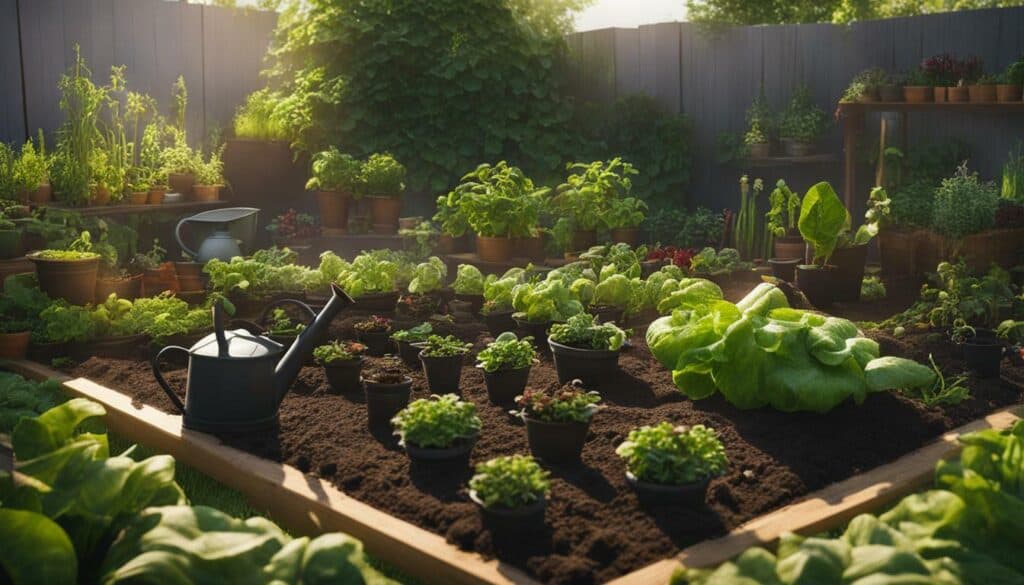
Proper Soil Preparation
Learn the techniques for proper soil preparation that will set the foundation for a thriving garden. When it comes to horticulture, one of the most important steps is preparing the soil to create the ideal conditions for plant growth. By understanding the depth and extent of root systems, you can ensure that your plants receive the necessary nutrients and support.
First and foremost, it is crucial to remove any fill soil that may hinder root development. Fill soil often contains waste materials and lacks the necessary nutrients for plants to flourish. Replace it with loam, a nutrient-rich soil that provides the ideal environment for root growth. Loam is a balanced combination of sand, silt, and clay, allowing for proper drainage and retention of moisture.
In addition to proper soil composition, fertilizing is essential for providing the necessary nutrients for plant growth. Adding natural fertilizers like well-rotted cow manure or dehydrated manure can enrich the soil and promote healthy root development. Another beneficial source of nutrients is seaweed, which contains minerals that are beneficial for plants. Incorporating these organic fertilizers into the soil will ensure that your plants have the essential nutrients they need to thrive.

| Techniques for Proper Soil Preparation | Benefits |
|---|---|
| Remove fill soil and replace it with nutrient-rich loam | Provides optimal growing conditions for plants |
| Add natural fertilizers like well-rotted cow manure or seaweed | Enriches the soil with essential nutrients |
| Ensure proper drainage and moisture retention | Promotes healthy root development and prevents waterlogging |
By following these techniques for proper soil preparation, you will create an ideal environment for your plants’ root systems to thrive. This will ultimately lead to healthy and flourishing plants in your garden. With the right foundation, you can embark on a successful horticultural journey and enjoy the fruits of your labor.
Nutrients for Plant Growth
Discover the secret to providing the right nutrients for your plants’ growth in this section. In horticulture, it is crucial to understand the importance of nourishing your plants with the necessary nutrients. Factual data suggests that garden plants, including tomatoes, corn, and pepper plants, develop root systems that can extend over four feet deep. This knowledge emphasizes the significance of proper soil preparation to ensure optimal growth.
When cultivating shrubs or flowers, it is vital to have loam soil, which is rich in organic material. It is recommended to remove any fill soil, as it often contains waste materials that can negatively impact plant health. By replacing it with loam, you provide your plants with a favorable environment for root development and nutrient absorption.
Adding natural fertilizers can further enhance the nutrient content of the soil. Well-rotted cow manure is a popular choice, as it releases nutrients gradually over time. Another valuable source of minerals is seaweed, which can be used in a dried form. By incorporating these organic fertilizers, you can supply your plants with the essential nutrients they require for healthy growth.
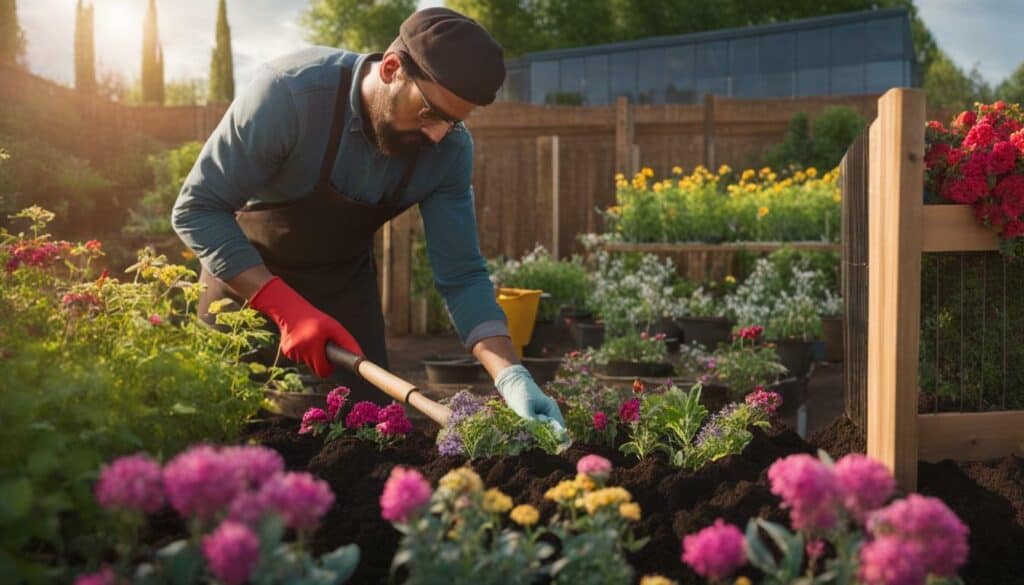
Table 1: Essential Nutrients for Plant Growth
| Nutrient | Function | Sources |
|---|---|---|
| Nitrogen (N) | Stimulates leaf and stem growth | Well-rotted cow manure, compost, fish emulsion |
| Phosphorus (P) | Promotes root development and flowering | Bone meal, rock phosphate, bat guano |
| Potassium (K) | Enhances overall plant health and disease resistance | Kelp meal, wood ash, granite dust |
| Calcium (Ca) | Strengthens cell walls and prevents disorders | Eggshells, gypsum, limestone |
| Magnesium (Mg) | Aids in chlorophyll production | Epsom salt, dolomite lime, seaweed |
“Proper nutrition is the foundation for healthy plant growth. Providing your plants with the right balance of essential nutrients will ensure their vitality and productivity.”
By following these horticulture tips and techniques, you can create an environment that supports the growth and well-being of your plants. Remember to consider the depth and extent of root systems when preparing your soil, and opt for loam soil to provide the ideal conditions. Incorporating organic fertilizers such as well-rotted cow manure and seaweed will supply your plants with the necessary nutrients for optimal growth. With these secrets in mind, you’ll be well on your way to becoming a successful gardener.
Green Thumb Secrets
Uncover the green thumb secrets that experienced gardeners use to create stunning gardens and thriving plants. In horticulture, it is important to consider the depth and extent of plants’ root systems. Did you know that the roots of garden plants, such as tomatoes, corn, and pepper plants, can grow over four feet deep? Understanding the size and volume of root systems is crucial for proper soil preparation and plant growth.
When planting shrubs or flowers, it is essential to have loam, a type of soil rich in organic material. Fill soil, which often contains waste materials, should be removed and replaced with proper loam. This nutrient-rich soil provides an ideal environment for roots to absorb water and nutrients, leading to healthier plants and higher yields.
Another green thumb secret is the use of natural fertilizers. Adding well-rotted cow manure or dehydrated manure can provide the necessary nutrients for plant growth. Seaweed is also a beneficial source of minerals for plants. These organic fertilizers not only nourish the soil but also improve its structure, promoting better root development and overall plant health.
By following these green thumb secrets, gardeners can ensure healthy and thriving plants in their horticultural endeavors. Remember, understanding root systems, using nutrient-rich soil like loam, and providing the right fertilizers are key factors in achieving successful horticulture.
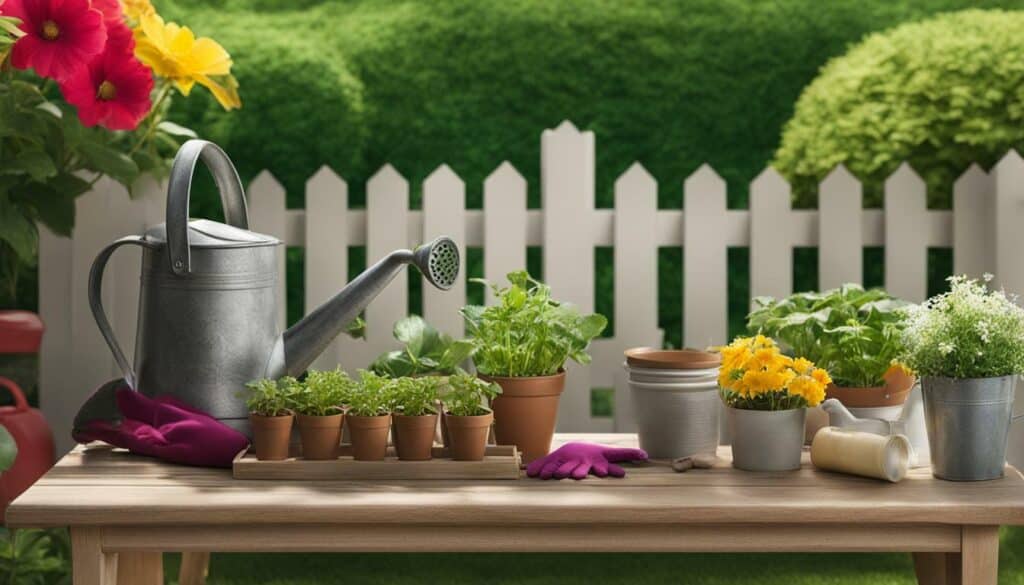
Green Thumb Secrets
- Understand the depth and extent of plant root systems for proper soil preparation.
- Replace fill soil with nutrient-rich loam to provide an ideal growing environment.
- Use natural fertilizers like well-rotted cow manure and seaweed to provide essential nutrients.
Implementing these green thumb secrets will set you on the path to creating stunning gardens and achieving horticultural success.
Troubleshooting Common Issues
Learn how to troubleshoot common issues that may arise in your garden and keep your plants thriving. As a horticulturist, it’s important to be aware of potential problems and have the knowledge and tools to address them effectively. Here are some common issues you may encounter and how to overcome them:
Pests and Diseases
One of the most common challenges in horticulture is dealing with pests and diseases that can damage your plants. From aphids and snails to fungal infections, these issues can quickly impact the health of your garden. To combat these problems, it’s essential to regularly inspect your plants for any signs of infestation or disease. If you spot any pests, you can try natural remedies like neem oil or insecticidal soaps to control their population. For diseases, removing infected parts of your plants and applying appropriate fungicides can help prevent further spread.
Nutrient Deficiencies
Inadequate nutrient levels can result in stunted growth and poor overall health of your plants. Common nutrient deficiencies include nitrogen, phosphorus, and potassium, which are essential for plant growth. To address these deficiencies, you can use organic fertilizers or compost to replenish the nutrients in your soil. Additionally, foliar sprays can provide a quick boost of nutrients directly to the leaves of your plants.
Watering Issues
Proper watering is crucial for the well-being of your plants. Overwatering can lead to root rot, while underwatering can cause dehydration and wilting. It’s important to find the right balance and water your plants according to their specific needs. Observe the soil moisture levels and adjust your watering schedule accordingly. Using mulch around your plants can also help retain moisture and prevent evaporation.
| Common Issues | Troubleshooting Tips |
|---|---|
| Pests and Diseases | Regularly inspect your plants, use natural remedies, and apply appropriate fungicides. |
| Nutrient Deficiencies | Use organic fertilizers or compost to replenish nutrients, and consider foliar sprays for a quick nutrient boost. |
| Watering Issues | Find the right balance, observe soil moisture levels, and use mulch to retain moisture. |
By understanding and addressing these common issues promptly, you can ensure the health and vitality of your garden. Remember to stay vigilant, provide the necessary care, and consult with experts or fellow gardeners if needed. Happy gardening!
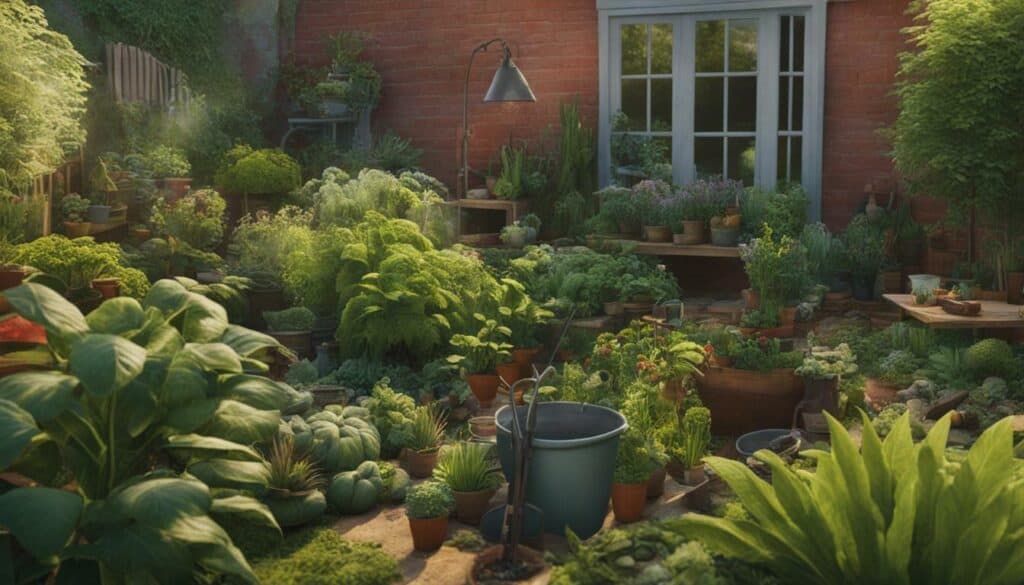
Harvest and Enjoy
Discover the proper techniques for harvesting your homegrown produce and enjoy the fruits of your labor. After dedicating time and effort to nurturing your plants, it’s time to reap the rewards. Harvesting at the right time ensures the best flavor and freshness for your homegrown fruits, vegetables, and herbs. Let’s explore some horticulture tips and techniques to make the most of your harvest.
When it comes to harvesting, it’s important to know the signs that indicate your produce is ready to be picked. Each type of plant has different indicators, so it’s essential to do some research specific to the plants you’re growing. For example, tomatoes should be harvested when they are bright in color and firm to the touch, while leafy greens like lettuce can be harvested when the outer leaves are large enough to be picked.
“Harvesting at the right time ensures the best flavor and freshness for your homegrown fruits, vegetables, and herbs.”
Once you’ve determined that your produce is ready to be harvested, it’s time to gather your tools. A sharp pair of scissors or garden shears will come in handy for cutting through stalks and stems. Remember to handle your plants with care to avoid damaging them or bruising the produce.
After harvesting, you can enjoy your homegrown bounty in a variety of ways. Freshly picked fruits and vegetables can be used in salads, stir-fries, or juiced for a nutritious and flavorful boost. You can also preserve your harvest by canning, freezing, or drying them for future use. The possibilities are endless, and the satisfaction of enjoying produce you’ve grown yourself is truly rewarding.
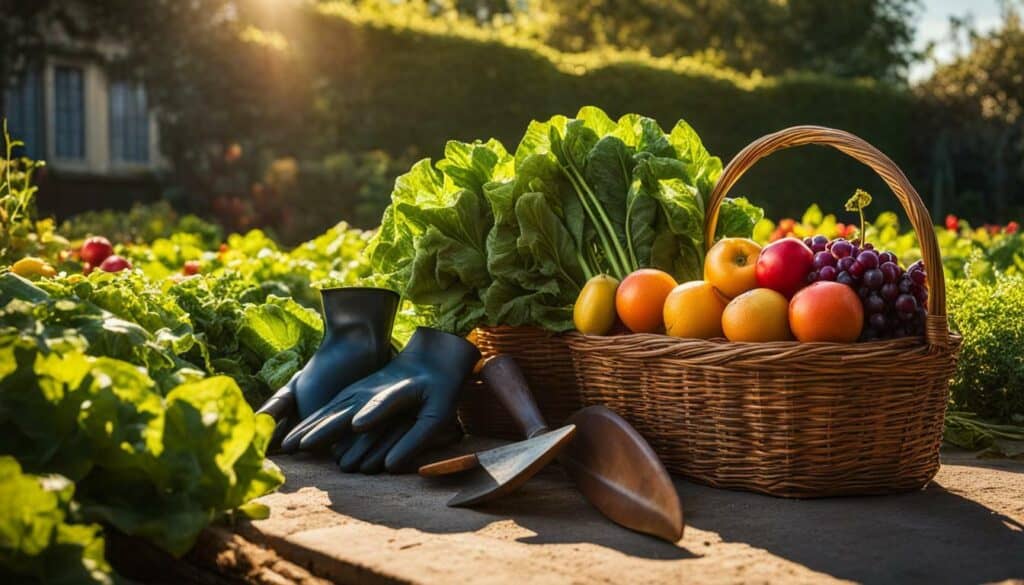
| Plant | Indicators of Readiness |
|---|---|
| Tomatoes | Bright color and firm texture |
| Lettuce | Outer leaves are large enough to be picked |
| Strawberries | Red and fully ripe |
| Carrots | Visible carrot tops emerging from the soil |
With these horticulture tips and techniques, you’ll be able to confidently harvest your homegrown produce and savor the delicious flavors of your garden. Happy harvesting!
Conclusion
Congratulations! You have completed your ultimate guide to horticulture, and I hope you are now equipped with the knowledge and inspiration to create your own thriving garden.
In horticulture, understanding the depth and extent of plants’ root systems is crucial for proper soil preparation and plant growth. Garden plants like tomatoes, corn, and pepper plants can have root systems that extend over four feet deep. By considering the size and volume of root systems, you can ensure that your plants have the optimal conditions for growth.
When planting shrubs or flowers, it is essential to have loam, a type of soil that is rich in organic material. It is important to remove fill soil, which often contains waste materials, and replace it with proper loam. Additionally, adding fertilizers like well-rotted cow manure or dehydrated manure can provide the necessary nutrients for plant growth. Seaweed is also a beneficial source of minerals for plants.
By following these green thumb secrets and implementing the techniques and tips shared throughout this guide, you can ensure that your horticultural endeavors are successful. Whether you have a small balcony or a spacious backyard, horticulture is accessible to everyone, and it is a deeply satisfying hobby that allows you to connect with nature and create beautiful and productive gardens.
FAQ
Q: How deep can the roots of garden plants grow?
A: The roots of garden plants, such as tomatoes, corn, and pepper plants, can grow over four feet deep.
Q: What type of soil is best for planting shrubs or flowers?
A: It is essential to have loam, a type of soil rich in organic material, for planting shrubs or flowers.
Q: What should be done with fill soil?
A: Fill soil, which often contains waste materials, should be removed and replaced with proper loam.
Q: What are some natural fertilizers that can provide nutrients for plant growth?
A: Well-rotted cow manure, dehydrated manure, and seaweed are beneficial sources of nutrients for plants.
Q: How can I ensure healthy and thriving plants in my garden?
A: By following green thumb secrets, such as proper soil preparation and providing the right nutrients, you can ensure healthy and thriving plants in your garden.
Can I Use Horticulture Techniques to Improve My Gardening Skills?
Using proper gardening techniques is an effective way to enhance your gardening skills. Horticulture techniques, such as selecting the right plants for your climate, understanding soil composition, and learning about proper watering and pruning methods, can significantly improve your gardening abilities. By implementing these techniques, you can create a healthier and thriving garden.

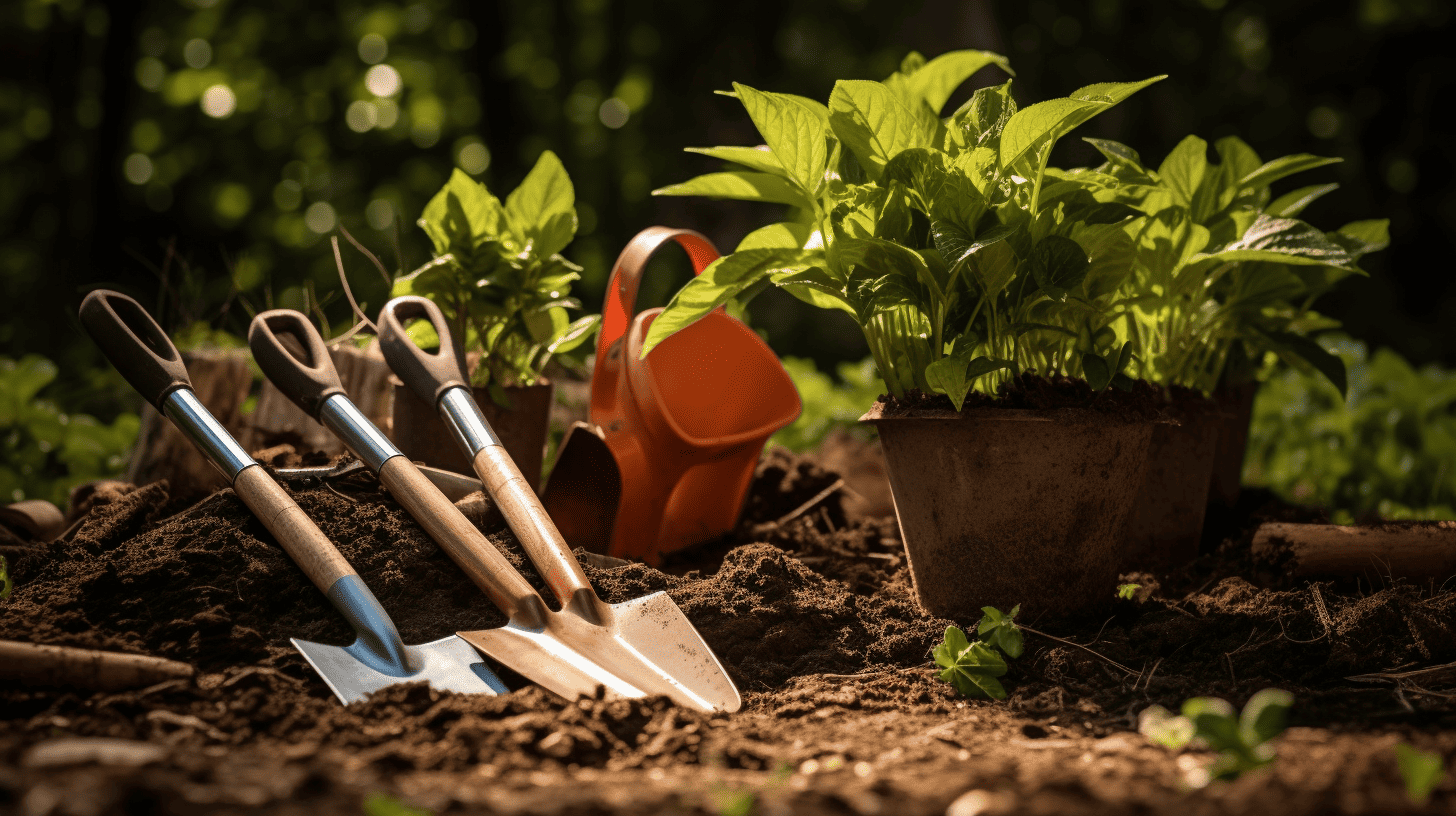



Leave a Reply